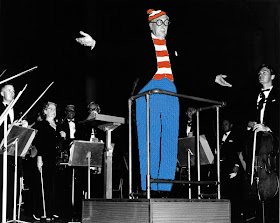Why surprising? For one because of general concert-goers’ attitudes, especially of conservative German audiences. If a work wasn’t in the repertoire by about 1930 or composed by Richard Strauss, then it has a very hard time finding acceptance, irrelevant of how much a masterpiece it is. The case of Sibelius shows that plainly enough—he dropped off the radar around the 1940s (his music too closely embraced by the Nazis and subsequently denigrated by the aesthetic elite of the land) and never clawed his way back to the status that ought to be his. If Sibelius is neglected, and Nielsen ignored, imagine poor Walton’s standing. “Walton-who?” Exactly!
 W.Walton, Collected Works, (Symphony No.11, the 3 Concertos, Sinfonia Concertante 1LSO / A.Previn RCA     |
Ironically the ‘attractive’ part of this open-face music-sandwich was another romantic 20th century work, 25 years older than Walton’s 1935 Symphony… one that has established itself. Why? Early-enough introduction in the intangible repertoire hall of fame, shameless seduction, and in the 90s a great, slightly cheesy movie: Rachmaninoff’s Third Piano Concerto, performed in this case by Kirill Gerstein. (Of course even Rachmaninoff didn’t have the recipe for permanent success: With his piano concertos Rachmaninoff gave the audience sugar; with his less popular symphonies, diabetes.)
For all the anticipation, I was prepared for a reasonably well-intentioned mess in the difficult Walton, but the result was considerably more than that. Bychkov, who has performed and toured the Symphony with the WDR SO (broadcast on 3sat), pushed the unrelenting first movement of the symphony firmly. The strings supply the rhythm, winds play melodic fragments above them, and the impression is repeatedly that of a distant relative of a Sibelius symphony. With its parts—black with notes—more pages long than it lasts minutes (40-45), it’s exhausting fare for musicians, neither easy to rehearse nor play.
This (prudently chosen) third of three performances still wasn’t wholly crisp, and a little under-enthused, but it was also professional and coherent. The gradually more gripping and intense slow movement was outstanding. Only the fourth movement slacked aimlessly until the timpani-driven climax reintroduced direction and Bychkov’s talent for ‘loud’ came to the fore. Walton may have ended up far from home, and a good deal away from greatness, but also fascinating and exciting.
For all the anticipation, I was prepared for a reasonably well-intentioned mess in the difficult Walton, but the result was considerably more than that. Bychkov, who has performed and toured the Symphony with the WDR SO (broadcast on 3sat), pushed the unrelenting first movement of the symphony firmly. The strings supply the rhythm, winds play melodic fragments above them, and the impression is repeatedly that of a distant relative of a Sibelius symphony. With its parts—black with notes—more pages long than it lasts minutes (40-45), it’s exhausting fare for musicians, neither easy to rehearse nor play.
This (prudently chosen) third of three performances still wasn’t wholly crisp, and a little under-enthused, but it was also professional and coherent. The gradually more gripping and intense slow movement was outstanding. Only the fourth movement slacked aimlessly until the timpani-driven climax reintroduced direction and Bychkov’s talent for ‘loud’ came to the fore. Walton may have ended up far from home, and a good deal away from greatness, but also fascinating and exciting.


